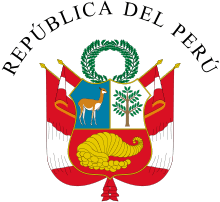Constitution of Peru
The Constitution of Peru is the supreme law of Peru. The current constitution, enacted on December 31, 1993, is Peru's fifth in the 20th century and replaced the 1979 Constitution.[1] The Constitution was drafted by the Democratic Constituent Congress that was convened by President Alberto Fujimori during the Peruvian Constitutional Crisis of 1992 that followed his 1992 dissolution of Congress, was promulgated on December 29, 1993. A Democratic Constitutional Congress (CCD) was elected in 1992, and the final text was approved in a 1993 referendum.
 |
|---|
| This article is part of a series on the politics and government of Peru |
| Constitution |
|
|
|
|
Autonomies
|
|
|
|
|
|
|
The current Constitution of Peru differs from the 1979 Constitution in that it gives greater power to the president. For example, it allowed for reelection, reduced the bicameral 240-member congress to a unicameral 120 Congress of the Republic,[2] not only affirmed the president's power to veto found in the 1979 Constitution, but also gave him the power to use a line item veto, and mandated that all tax laws receive prior approval by the Ministry of Economics and Finance. While the Constitution of 1979 allowed the president to dissolve congress after congress censured cabinet members three times, the current constitution allows the president to do so after only two censures. The Constitution allows the president to decree laws as long as he first informs the Congress of his intent to do so. If the president dissolves Congress, the Constitution gives him the power to rule until the election of a new Congress within a four-month timeline, during which time the Standing Committee of the dissolved Congress will remain functioning.
Following the ouster of President Alberto Fujimori, the Constitution was amended to bar the president from immediate re-election, a status quo that had prevailed for most of the time since the Great Depression.
History
Peru has had twelve constitutions (1823, 1826, 1828, 1834, 1839, 1856, 1860, 1867, 1920, 1933, 1979 and 1993), four provisional statutes (1821, 1855, 1879 and 1883) and one confederate constitution during Peru–Bolivian Confederation (1837).[3]
1979 Constitution
The 1979 Constitution was promulgated on July 12, 1979 by a Constituent Assembly elected in June 1978 following 10 years of military rule and replaced the suspended 1933 Constitution. It became effective in 1980 with the re-election of deposed President Fernando Belaúnde Terry. It limited the president to a single five-year term and established a bicameral legislature consisting of a 60-member Senate (upper house) and a 180-member Chamber of Deputies (lower house). It also eliminated the literacy requirement for voting and extended suffrage to all adults 18 or older.
References
- Economist Intelligence Unit (2005-01-12). "Country Briefings: Peru – Political forces". The Economist. Retrieved 2007-02-23.
- "Peru: Government". Encyclopedia of the Nations – Americas. Thomson Gale. 2006. Retrieved 2007-02-23.
- "Archived copy" (PDF). Archived from the original (PDF) on 2019-10-19. Retrieved 2019-10-19.CS1 maint: archived copy as title (link)
External links
- (in Spanish) The Constitution of Peru
- (in Spanish) Full text of each of Peru's historic constitutions
- (in English) English translation of the Political Constitution of Peru - translated by staff of the Translation Bureau of the Congress of the Republic of Peru.
| Wikisource has original text related to this article: |
.jpg)
.svg.png)